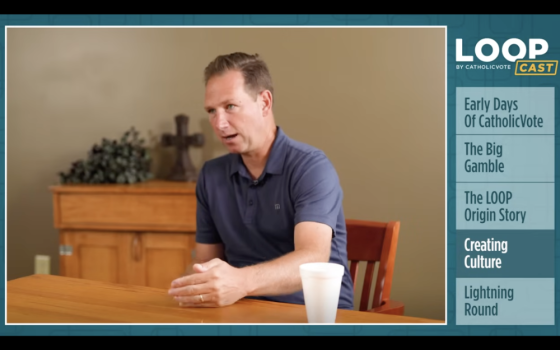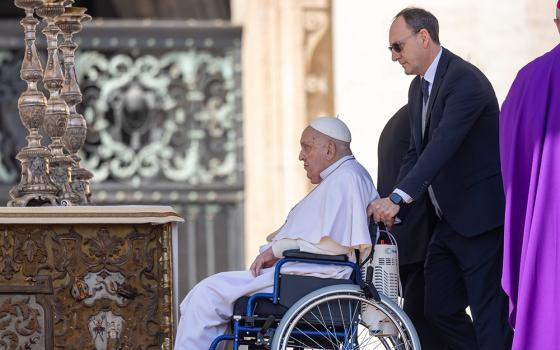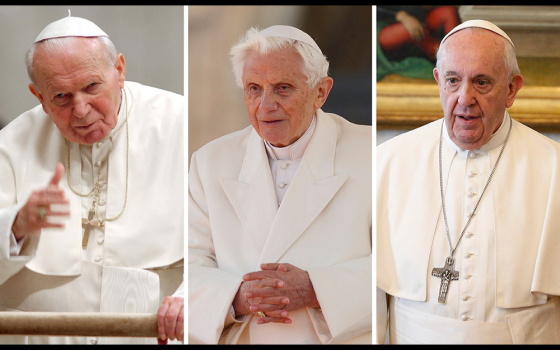
Pope John Paul II, left, Pope Benedict XVI and Pope Francis are seen in this composite photo. (CNS composite/Photos by Catholic Press Photo/Max Rossi; Paul Haring; Paul Haring)
Much of the coverage of Pope Francis' legacy on Monday (April 21) dwelt with the ways he differed from his predecessors, Pope John Paul II and Pope Benedict XVI.
It is natural to compare a pope to his predecessors and, in the long history of the church, the selection of a new pope has often evidenced a desire to maintain balance within the universal church. In the 19th century, the reactionary Pope Pius IX was succeeded by the more diplomatic Leo XIII who was, in turn, succeeded by the more conservative Pius X.
Unfortunately, many of the comparisons being made now betray an ideological edge that does no justice to the legacy of any of the three most recent popes.
"When Pope Francis was elected on March 13, 2013, the Vatican's reputation as a forceful, effective global advocate for basic human rights and a humane world order was at its apogee, thanks to the work of Francis's two papal predecessors, John Paul II and Benedict XVI," wrote George Weigel in the Washington Post. "Francis, who died Monday at age 88, does not leave a similar legacy. It will be up to his successor to rebuild a Catholic global witness now in disarray."
Disarray? There is an argument to be made for each of the criticisms Weigel voices but those arguments are not self-evident. For example, the deal the Vatican struck with the Chinese government over the appointment of bishops — a deal that remains secret so people like Weigel and me can't be sure of its stipulations — could be seen as ceding too much influence over the selection of bishops to the Chinese Communist Party.
The Holy See had similar concordats with regimes of equally suspicious moral character through much of its history. What Weigel fails to acknowledge is that there was a price to be paid for continuing the standoff between the regime and the church in China. Some brave Chinese Catholics think it was a price worth paying and others do not. Does it constitute, with the other examples, an "unhappy, even tragic, record?"
Nonsense. Francis built bridges when Weigel wanted him to build walls. Some bridges fail, others succeed. Time will tell, not Weigel.
Advertisement
Worse was the essay by the former archbishop of Philadelphia, Charles Chaput, at First Things. It was so churlish, I will not dignify it with a response.
In fact, there were elements of continuity and discontinuity between Francis' pontificate and those of his immediate predecessors.
All three recent popes met the changing needs of the times as they perceived them. In 1978, when John Paul II was elected, there was a sense that the centrifugal forces unleashed by the Second Vatican Council had grown too strong, that it was time to reassert the fact that the word "religion" comes from the Latin religiare, to bind. Pope Benedict XVI feared that the moral relativism of the ambient culture threatened the church's moral clarity. Francis saw that humanity was hurting, and that the church should become a "field hospital" where the wounded were treated, not castigated.
All three men brought their enormous talents to bear on the work of being pope. John Paul II displayed his tenacity and courage. Benedict XVI deployed his immense theological learning. Francis brought both a pastoral touch, and the insights of a pastoral theology rooted in the lived experience of the church, to his pontificate. The Catholic Church is better for having had such remarkable men in leadership the past four and a half decades.
Thirdly, all three popes were faithful to the teachings of the church and to the vision of Vatican II. True, the reception of Vatican II differed in Latin America from the reception in Poland and Bavaria, but all three men took their bearings from the teachings of the council. For all the fretting by conservative critics about "doctrinal confusion" under Francis, he did not change a single teaching of the church.
The shape of that fidelity, however, and the manner in which church teaching is proclaimed, are where we can discern some of the differences between the three popes. For example, the emphasis on moral clarity under both John Paul II and Benedict XVI left many with the impression that someone was standing at the door to the church with a checklist, and if you didn't pass, you could not be given access.
Francis realized that this perception had the effect of gutting the Gospel of its most essential teaching, that God's mercy is greater than any of our sins. So, for example, on the issue of whether or not the divorced and remarried can take Communion, Francis never denied the indissolubility of marriage. He also pointed out that the church teaches that Communion is not a prize for the perfect, but instead is a medicine of mercy, and allowed the divorced and remarried, under certain circumstances, to partake of the sacrament. It was not the teachings that changed, but the relative weight given to the two teachings did and, consequently, a pastoral application of the teachings was altered.
Francis wanted to welcome everyone. "Todos, todos, todos" ("everyone, everyone, everyone") became one of his refrains. He rejected the idea that gay and lesbian Catholics were somehow beyond the pale. He understood that using the term "intrinsically disordered" to describe homosexuality may be theologically precise but it was a disaster pastorally. He did not change any doctrine, but he understood the limits of certain technical theological terms when spoken outside a classroom.
As you listen to or read various commentators this week, keep the salt handy because you may need several grains of it.
In other cases, it was Francis' direct way of speaking that distinguished him from his predecessors. Since 1891, popes have offered a sustained critique of modern capitalism. The right to private property is acknowledged in church teaching, but it is a secondary teaching compared to the universal destination of goods, the ancient belief that God created the world for all his creatures. Leo XIII, Pius XI, John XXIII, Paul VI, John Paul II and Benedict XVI all, in various ways, voiced the church's concern with capitalism, but they did so in theological language that was sometimes opaque. Francis, referencing an economy of exclusion and inequality, wrote, "Such an economy kills." Conservative American Catholics who had tried to fudge the church's teachings on capitalism couldn't do much with such a succinct, direct statement.
Finally, there was a trajectory of confronting clergy sex abuse that ran through all three papacies. John Paul II refused to face the problem, for example, promoting the late Theodore McCarrick four times. Benedict began to face it, removing Fr. Marcial Maciel Degollado from ministry, but never faced the fact that the cover-up was as bad its way as the crime of abuse itself. Francis, with the promulgation of Vos Estis Lux Mundi in 2019, finally established a procedure for holding bishops accountable for covering up sex abuse.
As you listen to or read various commentators this week, keep the salt handy because you may need several grains of it. People like Weigel and Chaput will seek to highlight the differences between Francis and his predecessors, comparing him unfavorably to their favorites. Don't buy it. There were differences, yes, but the similarities were just as pronounced.





